How to Grow and Care for Onions
The fundamental considerations and subtle nuances of growing and caring for onions are beyond the scope of this introduction to plant care. Please see our Resource Center where we offer additional instructional videos and articles, as well as our bookstore.
Soil Preparation to Grow Onions:
Onions prefer loose, well-drained soils that are high in fertility, slightly acidic, adequately irrigated and exposed to full sunlight. The looser the composition of your soil, the larger your onion bulbs will grow. Prepare your bed by turning under animal manure or plant residue based compost. Please make sure that this material is fully broken down before planting.
Compost composed of cedar or redwood is not an acceptable substitute for high quality compost.
The potential for fungus diseases like downy mildew and pink root can be greatly reduced in certain circumstances. Especially by avoiding beds where onions, garlic and other alliums have been grown within the last two years. This time period is a basic rule of thumb but, in general, “the longer the better”. As gophers are a major pest in onion beds, use gopher traps, wire barriers or wire baskets prior to and during planting.
Growing Onions from Seed
Onions are easy to grow from seed and can be started about 10-12 weeks before you are ready to transplant them outside. If you live in very cold winter regions, start seeds indoors in February or plant directly in the garden in warm winter regions. Use a good quality seed starting mix and sow about 1/2” deep. Onions seeds can take up to a week to germinate and are pretty slow growing, just keep the soil moist and once seeds have germinated, supply them with a good grow light or place in a sunny window. When the seedlings are about 2”, you can feed them with a very dilute solution of fish and kelp (follow the directions on the label). Once you are ready to transplant them out in the garden (daytime temps should be at least 50°F), trim the tops to about 4” and plant about 2” deep and 4-6” apart. The soil should be loose and have a good supply of phosphorus. Keep the bed well weeded as onions do not like competition from weeds or other plants.
Planting Onion Transplants
Onion transplants can be grown up from seed or purchased as plants–typically available in fall & spring. Fall is the optimum time to plant onions in mild climates. Onion transplants are often wilted when they arrive. Like other members of the hardy lily family, they will survive for about 2-3 weeks after being pulled from the soil.
If you cannot plant the onions immediately upon receipt, remove the transplants from the plastic bag. Please spread them out in a cool, dry location until ready for the garden. The sooner you plant the better!
Before planting, trim onion transplant tops to approximately 3” and roots to 1/4” - roots will begin to grow rapidly once planted. Plant onion transplants 1- 2 inches deep (to the top of white section) and 4-6 inches apart. Plant close as 3” apart if smaller onions are desired.
Rows should be 18”-24” apart or 12” apart if planting for commercial production. If planted on raised beds which are approximately 20” wide, transplants should be planted in double-rows 4” from each edge.
“Scatter planting” among vegetables in inter-planted gardens is sometimes utilized to ward off a variety of pests. Onions must not be forced to face heavy competition from surrounding neighbors.
Planting Onion Sets
Onions are easy to grow from sets. Plant 1” deep and 1-3” apart. Harvest young plants for use as scallions, thinning to 3-4” spacing. Onions should be mulched and supplied with ample phosphorus while growing.
Mulch deeply (up to 8”) in cold winter areas but only lightly in milder climates. Mulching will suppress weeds and maintain soil moisture. This is to protect onion bulbs from “heaving” (working their way out of the soil) during extreme temperature cycles. Weed suppression is critical for onions - you can grow weeds or onions, but not both.
Regular irrigation is necessary anytime rainfall is not sufficient to provide the 1” of water per week. That amount of water is required to keep bulbs from splitting in hot dry soil or tasting bitter at harvest. Water up until the time you harvest!
Beds kept weed free and properly irrigated will require little additional care.
Harvesting & Storage for Onions Plants
Onions are mature and ready to harvest when their tops have yellowed and begin to fall over. Finish bending the tops horizontal to the ground by hand or with a rake. This bending will stop the sap from diverting energy into the leaves while the bulb matures.
Harvest bulbs after the tops have turned brown. Place the tops of one row over the bulbs of another to keep them from becoming burned in full sun. When the outer skins have dried, complete harvesting by clipping the roots. Wipe off any remaining soil and cutting the tops back to 1” above the bulb.
Onions keep best when kept separated; individual foil wrapped specimens can last up to a year under refrigeration.
Pungent onion varieties, which have low water content, will keep longer than sweeter, moister types. Hang the onion bulb in a mesh bag in a ventilated location. It should be cool and dry. The onions should be separated from each other and they will maintain maximum shelf life.
Enjoy onions on your table and planting onion bulbs in your garden. We have many onion sets for sale and onion seeds for sale.



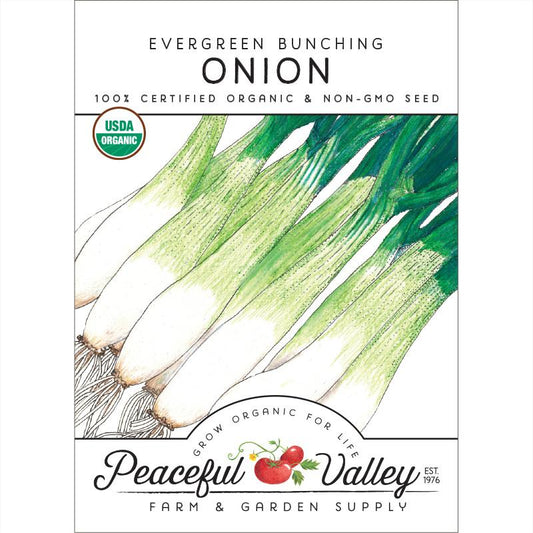
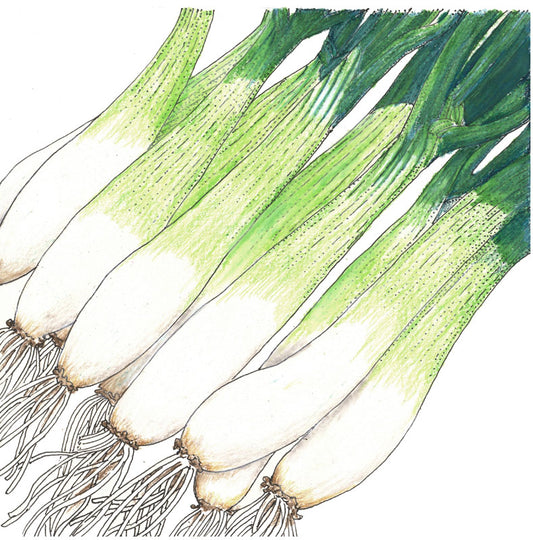
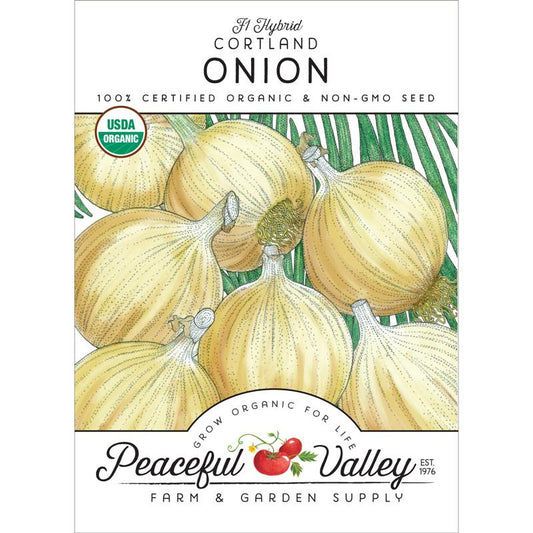
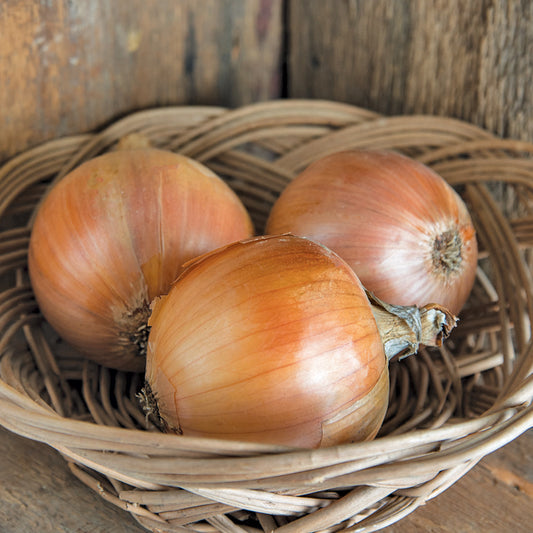
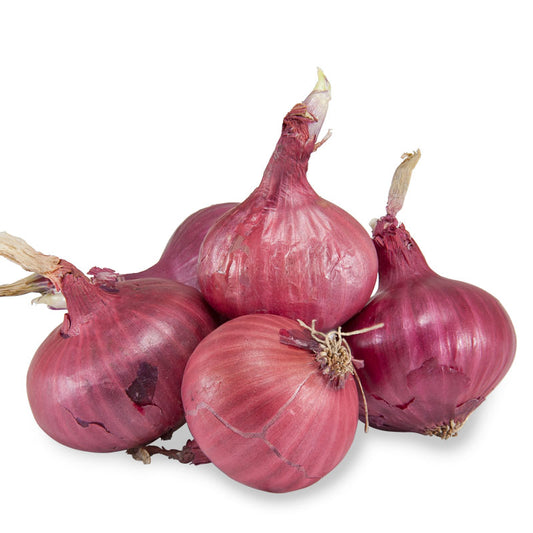
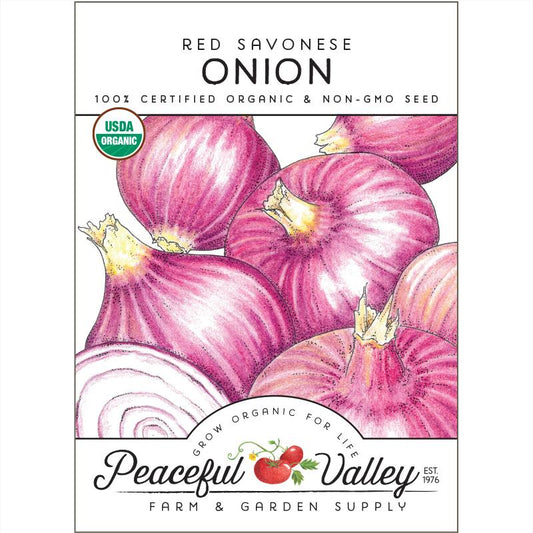
1 comment
How about some pointers for planting onions from seed — not just sets and plants?